It’s relatively easy to organise a gravel event when the weather gods smile on you. When the conditions change however and a red (danger to life) weather warning is issued by the state weather forecaster, that’s when an organiser really has to earn their stripes. With 60mm of rain forecast to fall over a four-hour period, would the participants in the 2025 edition of The Ride Gravel sink or swim? Read on to find out.
The rain is hammering so hard on the roof of my tent that my brain convinces me that I can feel drips landing on my sleeping bag. Outside I can hear the discomfiting noise of a forklift truck being operated at pace as The Ride Gravel event staff frantically try and break down and pack up the event village. The infrastructure needed to feed and look after 100+ hungry gravel riders is significant and having to dismantle it and pack it away safely, even though it’s pitch dark and the rain sounds monsoon-like in intensity, is a not a job I envy.
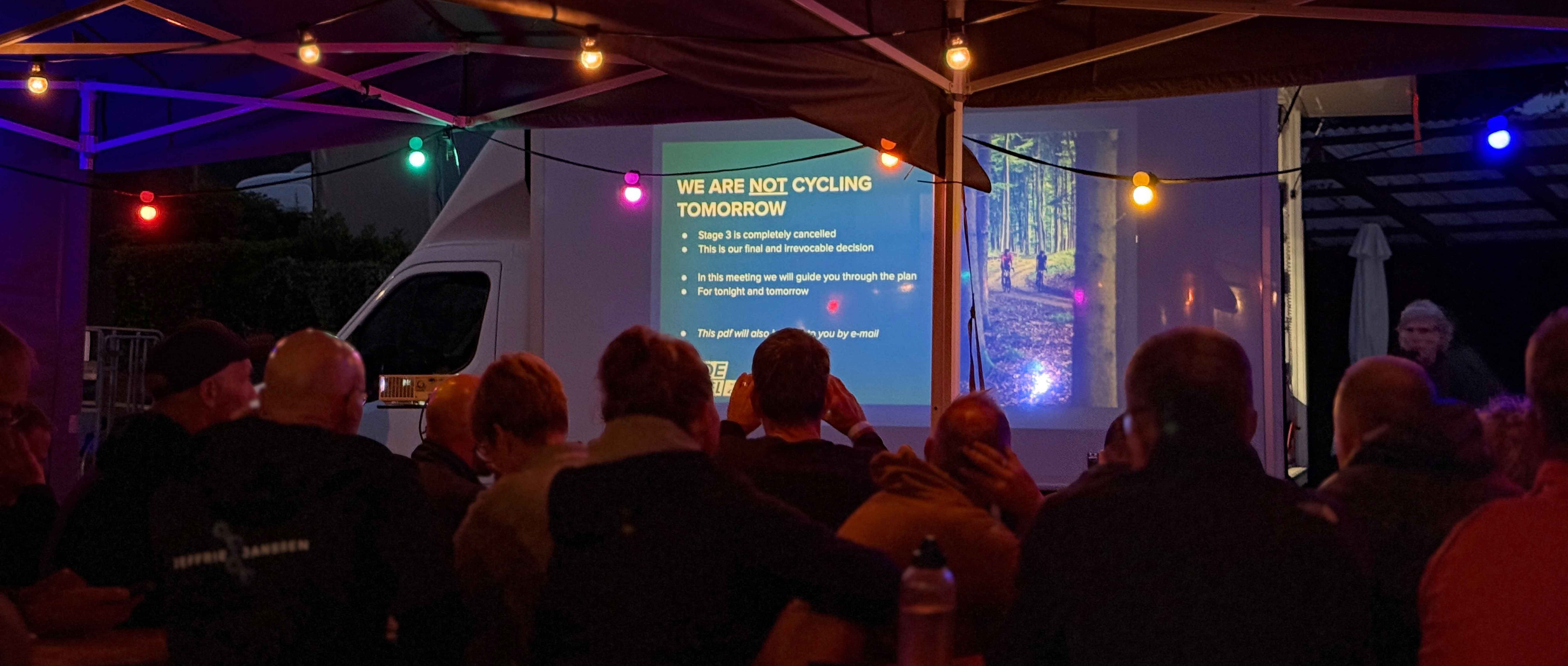
When the message came through from the event organising team that the daily post-dinner briefing was MANDATORY (written in full caps), we knew the news wasn’t going to be good. I’d spent a lot of time during the early part of the event riding with and socialising with Kenny and Maurits, who it transpired worked for the Dutch meteorological office. Their insight into what was happening with the weather as we rode along was impressive. Their predictions of what was likely to happen on Tuesday were issued with a level of professionalism and gravitas that left no room for doubt - we were going to get extremely wet.
The first morning of the event had dawned clear and bright. It was one of those perfect late summer/early autumnal days where you can sense that it will end up being hot, but there’s a chill to the early morning air. A low mist was draped gently over the heather-clad heathland near the campsite. Riders soon filled the catering marquee, shoveling in pre-ride calories and forming a gently snaking line to the coffee barista. There was an air of excitement, nervousness and eager anticipation. The Ride Gravel is non-competitive in nature, but there are some big days (up to 144km if you chose to ride the XL version of the route on Day 1 for example) and that’s enough to help generate a real buzz.

The 2025 edition of The Ride Gravel (which was "powered by Shimano GRX" as Carlo hilariously reminded us on a regular basis) was the fourth edition but unfortunately was destined to be the swansong too. The event is a non-competitive point-to-point gravel tour taking in some of the finest gravel riding to be found in The Netherlands and an annually changing carousel of neighbouring countries including Germany, Belgium, Luxumbourg and France depending on which year you took part. Despite the immense attention to detail that the organisers had put into running it and the full-service nature of the event, sign-up numbers had been declining and, as with all businesses, the organisers need to make a profit to succeed, so they had decided to “pause” it after the 2025 edition. It meant that I had been fortunate enough to ride along with the first edition and potentially the last edition too, which seemed somehow appropriate.
Each edition of the event had been completely different, but always follows a similar format. There are always five A-to-B stages (with longer and shorter route option most days); it’s camp-based (with a tented village that the amazing crew move daily); it’s fully catered and supported (so your luggage is transferred, there are regular feed stations during each stage, there are mobile mechanics and first aid support) and it attracts a diverse audience. The organisers have listened to feedback from participants each year and made tweaks – the first edition for example contained some quite technically demanding MTB-esque trails which proved to be a little too-Marmitey, so subsequent events saw a greater emphasis placed on more flowing gravel trails.
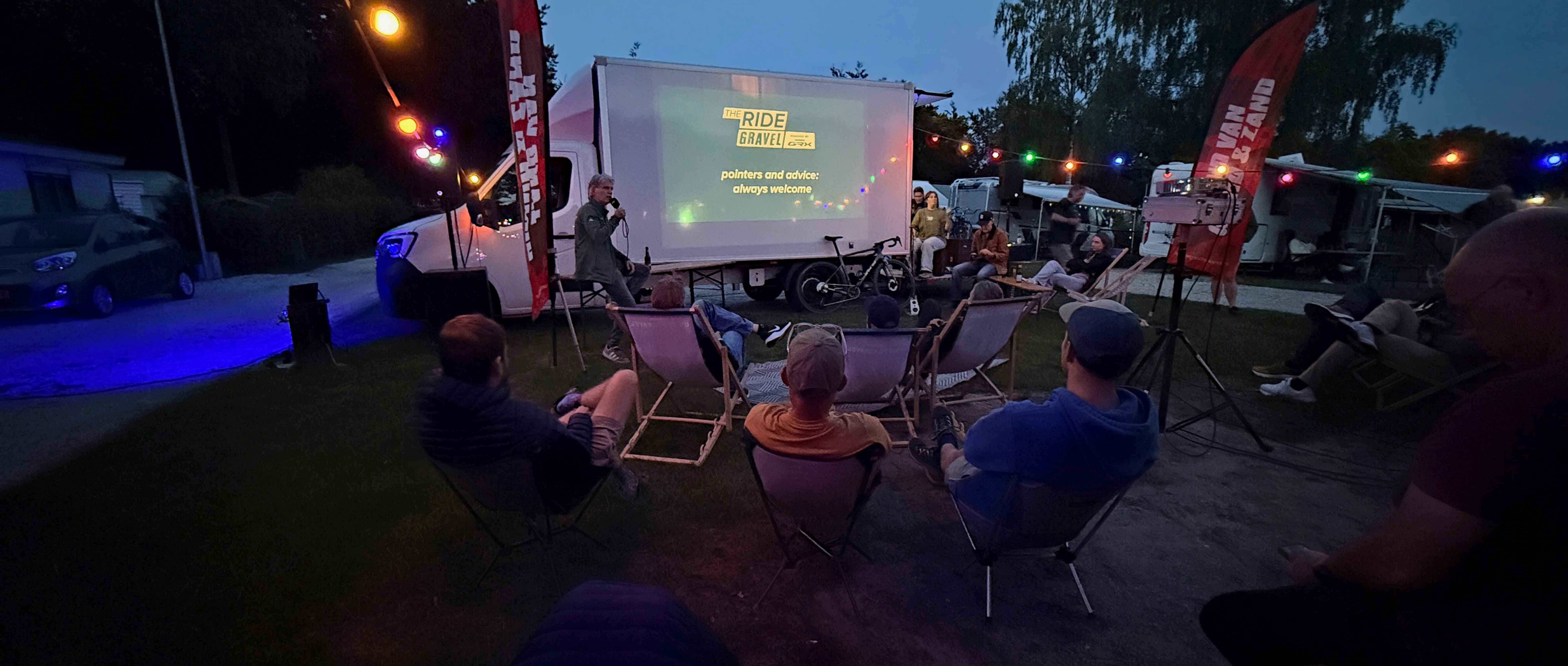
So, with such amazing support on offer, why hadn’t the event sold better? The headline price, if you chose an upgraded Camping Royal option and paid for a seat on the shuttle to the start point, was €1433. Considering that this included all your food, five days of fully-supported riding and having a posh dome tent complete with a camping bed and comfy mattress set-up and waiting for you each, it seemed like amazing value for money. Perhaps there was a finite number of gravel riders with the magic combination of free-time, money and desire to ride a multi-day event? Perhaps the lure of the ever-growing gravel racing scene had attracted some potential sign-ups? Whatever the reason, our mini-peloton was the perfect size in terms of feeling relaxed and laid back, so from a rider's perspective it was perfect.
Stage 1 – Fast & furious
To someone used to every ride containing a healthy dollop of vertical height gain, the profile of Stage 1 was quite a shock – essentially pan flat for the first 40 km and then marginally lumpier in the second half, but with a total climbing figure of less than 600m. What the course lacked in vert, it gained in headwind though. After an initial short northbound loop, the route headed due south straight into a block headwind for the majority of its length. Apart from the wind, the weather gods were firmly on our side with constant sunshine and vast azure skies. Weirdly, despite the flat terrain, I found this stage the toughest. With over 60% of the route being away-from-the-road I should have been in my element, but I actually found it mentally tough. A lot of the trails in the morning were very samey, without much technical challenge to spice things up. The profile was basically flat, but to me it seemed harder than a day in the mountains. I felt strangely guilty about not enjoying it as much as I should. Unlike the majority of the rest of the event, the trails were often busy with families, elderly couples and "normal people" out on their bikes, making the most of the sunshine. The afternoon's route was quite different to the morning, with a greater mix of terrain and types of trails. The headwind was still ever-present, but I enjoyed the riding much more.
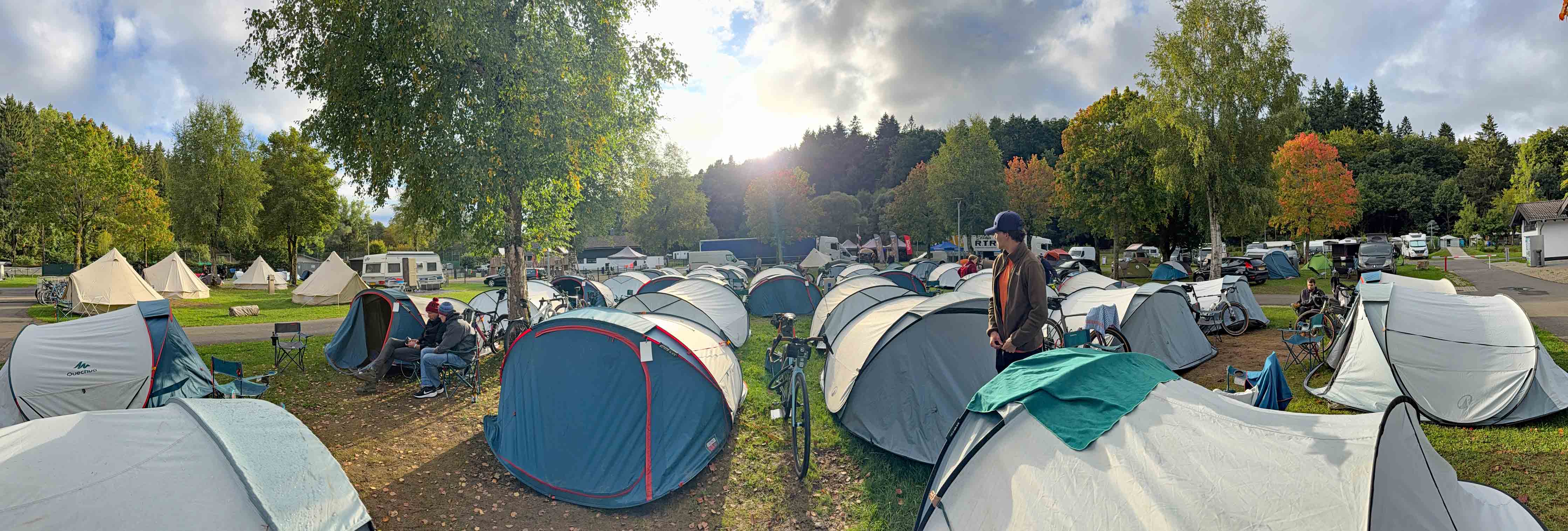
While we rode, a huge behind-the-scenes team of staff and volunteers dismantled everything from our first campsite, drove it to the next location and re-erected it. By the time the first riders rolled in, the event village was complete and riders who had paid a (small) premium to hire a tent, found their overnight accommodation in place and ready with a camping bed and comfy mattress installed inside. Two HGV trucks had been used to ship everything and as well as delivering our tents and luggage, a large catering marquee, kitchen, bar and coffee stand had all been shipped to the new location. This was multi-stage gravel done in style.
Stage 2 – Border Hopping
Time for our mid-morning coffee stop. We must be in The Netherlands, right? Or maybe we’re in Belgium? Or perhaps Germany. Before we had even reached the halfway point on Stage 2, we had crossed an international border eight times (I think). Coming from the insular nation of the UK, hopping speedily across an international border is something Brits can only dream of, yet at The Ride Gravel we did it so many times on Stage 2 that no-one was entirely sure which country we were in during the morning. None of the borders were marked, there were no staff there to stamp you into/out of their area of jurisdiction and often the only way you could tell where we were was to look at vehicle registration plates on the infrequent road linking sections.
In contrast to the blazing sunshine of Stage 1, the second stage started with incessant drizzle which combined with the warm temperatures generated a humid fug. Riders started in a motley collection of attire, with many (myself included) going for the generally frowned-upon combo of shorts, short sleeved jersey and waterproof overshoes. What I lost out on in style points, I gained by having dry feet. The parcours for Stage 2 was as different as the weather conditions with a greater percentage of tarmac and significantly more hills. Climbs varied from short, sharp efforts to longer drags and our overall height gain was more than triple that of the first stage.
The riding made me feel like I was riding at home in the UK. Every two minutes there was a change of surface, gradient, scenery. Urban cut through. Farm tracks. Fire roads. Woodland singletrack. Paved roads. Even a section which looked like we were riding through the car park of a fire station. There was plenty of tech too - one particular swoopy, sunken descent will live long in the memories of everyone - those who hooned down it and those who walked down it.
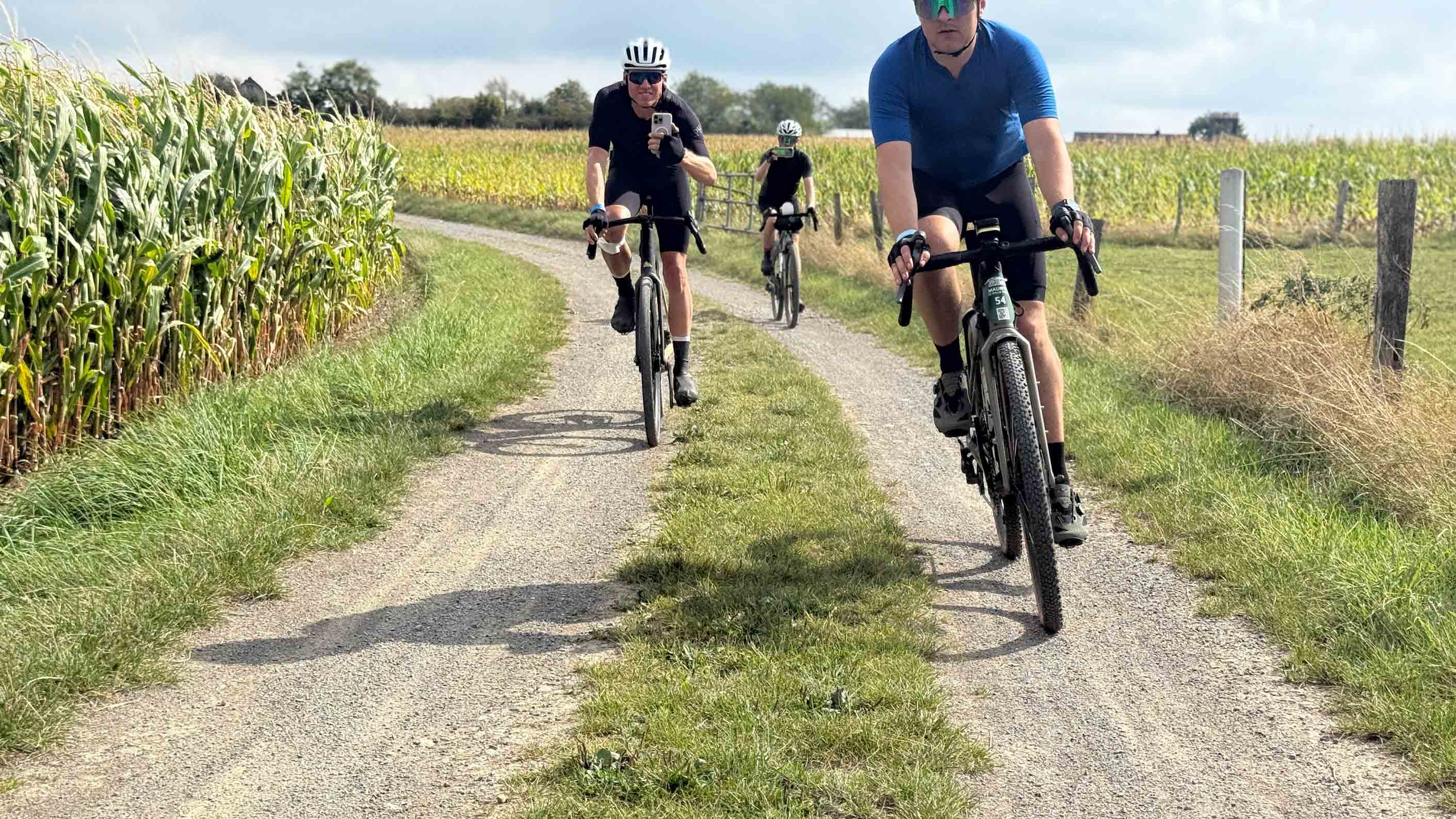
The ‘punchy’ terrain and ever-changing trail types of Stage 2 suited my riding style and trail preferences much more than the first stage and even with the damper conditions, I was a much happier camper when I arrived, along with ride buddies Kenny and Maurits. With their detailed meteorological knowledge we had spent the afternoon riding with one eye constantly scanning the sky and the omens didn’t look good. As we rolled into our third campsite, although we were greeted by warm sunshine, the skies behind us looked ominous.
Stage 3 – Wet, wet, wet. Cancelled
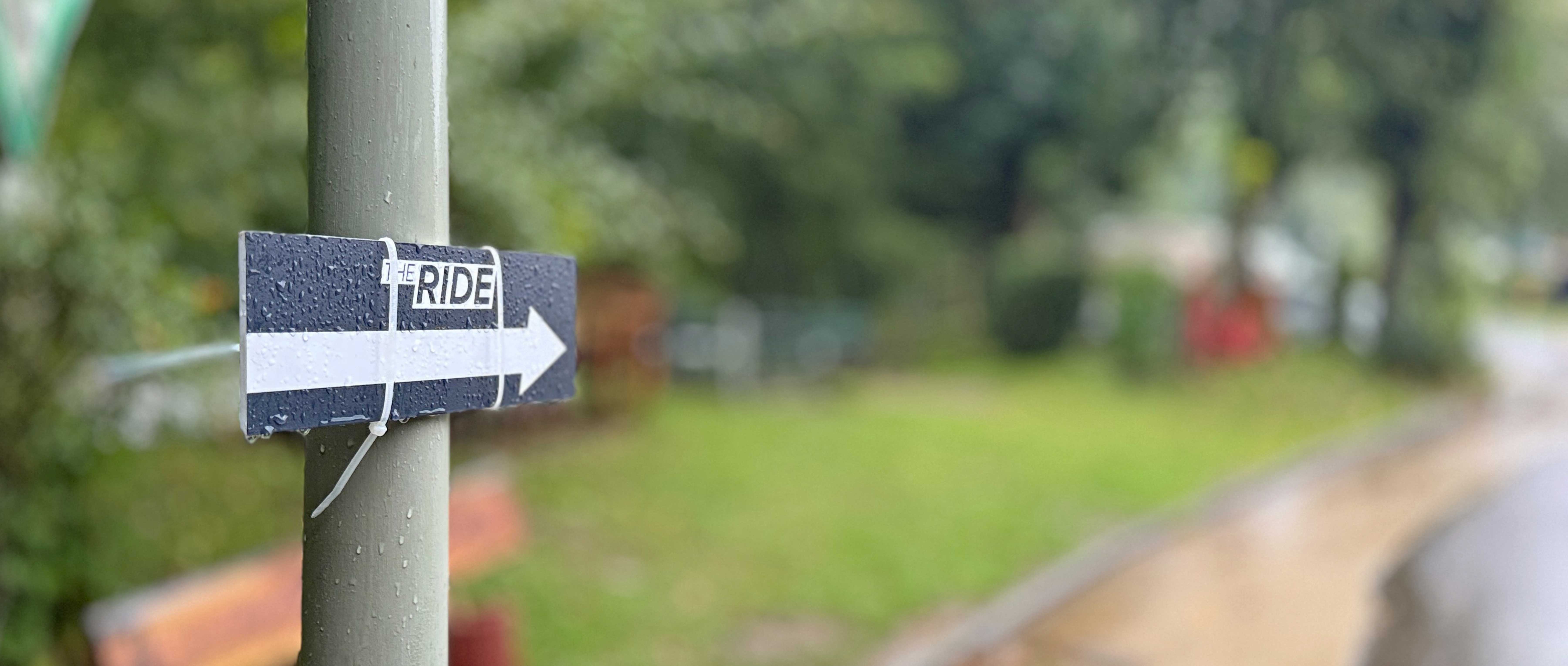
Waking up after a night of torrential rain is always a slightly trepidatious experience, particularly when you are camping. I opened my eyes, half expecting the floor of my tent to be under water (or at the very least, damp) but to my utter amazement and with impressive kudos to the design gurus at Decathlon, our tents were bone dry inside. At the nightly briefing at the end of Stage 2, event director Carlo had made it crystal clear that we were likely to be in for a bad night and participants were given a choice to sleep in hastily arranged communal accommodation spaces instead of their tents if they wanted. We had all been issued an emergency 24 hour call number and were told to contact the team if our tents became flooded and we needed rescuing. Fortunately the predicted 60mm of rain (equivalent to two weeks normal rainfall) had been dispersed more widely through the night rather than falling in one emergency-generating condensed period and the campsite had dealt admirably well with it.
Due to the dire weather warnings, by the time we woke up, the event crew had already dismantled and shipped the catering marquee and kitchen facilities to the next campsite. This meant the organisers needed to find a suitable space to feed a hundred hungry gravel riders. Fortunately the campsite owners found the perfect (if slightly cramped) spot and the catering team pulled a blinder by delivering warm-from-the-oven pain au chocolat to the assembled masses at breakfast. Rule 101 in the “How to deal with a crisis” handbook is to keep your troops fed and the catering team definitely came up trumps here. Despite the rain continuing to fall, the atmosphere was surprisingly upbeat and the uniform opinion was that the organising team had done an amazing job of keeping everyone safe in some seriously demanding circumstances.
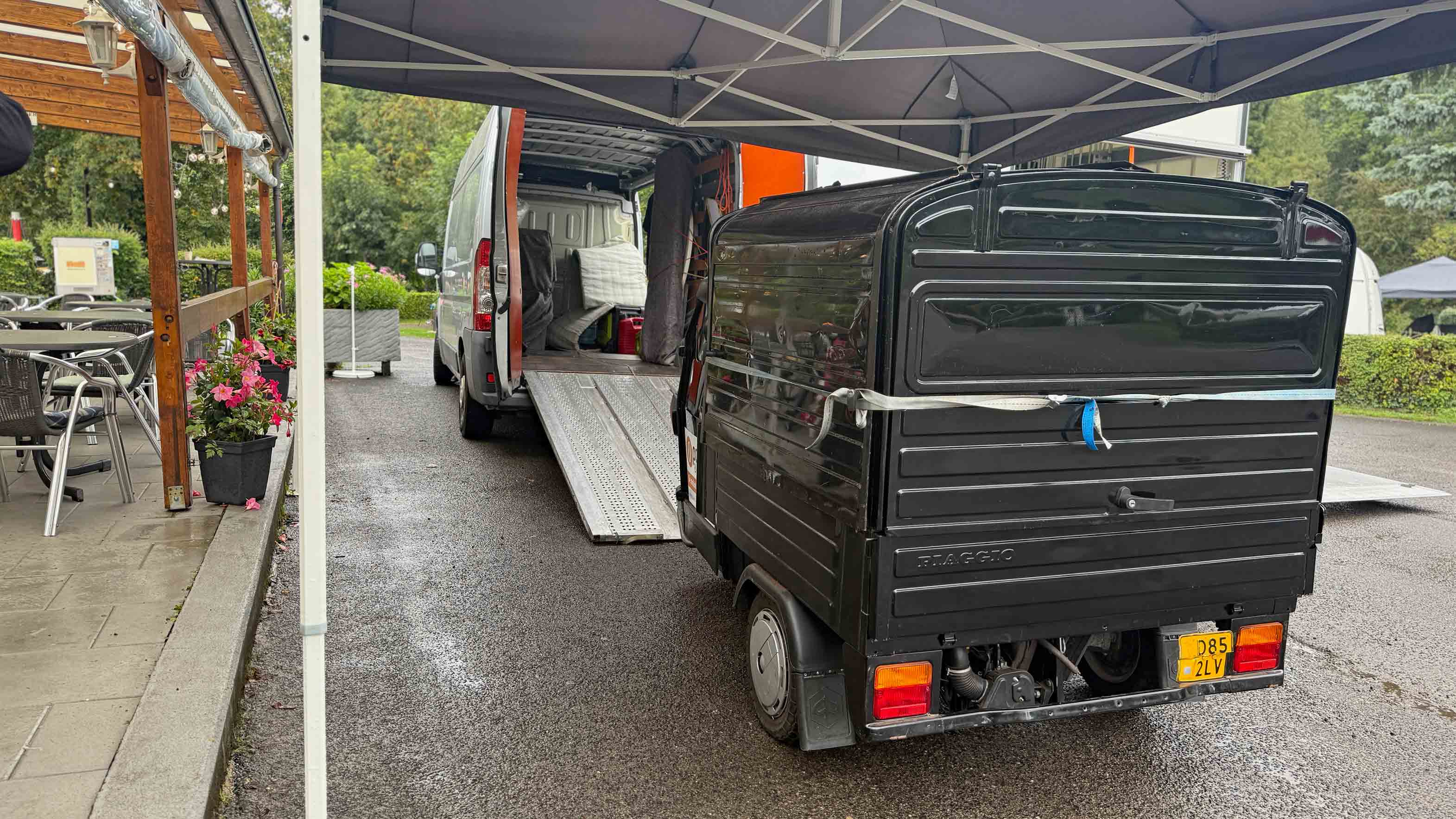
With everyone successfully fed, the event staff packed up the tents and remaining kit, the barista winched his coffee Ape into the back of his van and we were transferred by hastily arranged coach to the campsite at the end of what would have been Stage 3.
Stage 4 – German Galivanting
The weather forecast for Stage 4 was for the day to start off damp and foggy, but with sunshine predicted for the afternoon. As promised, we woke up to damp, muggy conditions. Surprisingly, considering the fact we hadn’t done any riding the day before (or perhaps because we hadn’t done any riding the day before) there were some heavy legs around the campsite and breakfast seemed a little subdued. Fortunately the route maestro, Jelmer Zeilstra, had a trick up his sleeve – after less than 1km of leaving the campsite the route turned right and took us straight up an impressively steep tarmac climb. With cold legs and lungs full of fug, it was quite a challenge, but it certainly woke everyone up.
The profile for the day was sawtooth-esque and riders who took on the XL version of the stage accumulated 2200m of climbing by the time we reached the next overnight campsite. As we progressed towards the first feed stop of the day, the sun started to burn through the early morning mist and the full splendour of autumnal forest riding was revealed. Long shadows, cobweb enmeshed trailside vegetation, mirror-like puddle reflections and warm, earthy colours meant the photographer in me was very happy. The constantly changing surfaces and the inclusion of a section of super fun, greasy as hell, root infested singletrack meant the rider in me was happy too!
We had been pre-warned in the previous day’s briefing about a couple of water crossings and the first duly appeared mid-morning. For anyone who had been paying attention (or who preferred to keep their feet dry), Carlo had told us that there was a bridge nearby to avoid getting a soaking, but for those with a sense of adventure or happy to play to the crowd of assembled photographers, it was the perfect opportunity for some aqua-action.
If I could sum up The Ride Gravel in one image, this would be it. A small gaggle of riders had formed a group which they christened the “grupetto”. The entry requirements seemed to be that you had to smile constantly, look after your fellow group-members and ride with a relaxed, but purposeful manner. I was lucky enough to wangle a coveted place and rode with them during the afternoon on Stage 4.
We’ll gloss quickly over my impromptu high speed lie-down shortly after I joined them (apologies for spoiling the relaxed atmosphere!) and just remember what a fun afternoon it was. The constantly changing terrain, beautiful light, captivating scenery and great company made this my highlight of the event.
Stage 5 – The grand finale
Oh good, rain beating down on the tent roof. That’s just how I like to start all my days on the bike :-( The Eiffel region of Germany is stunning. Lush woodland is wrapped over endless undulating hills like a comfort blanket. There’s a reason that it’s so green of course though – because it rains. A lot. I’ve been fortunate enough to have visited on four different occasions and on every one, it’s rained. “You must be used to this as a Brit” said one of the other event participants, smiling. They were of course right, but that didn’t make any less unpleasant.

I’d tried to ride with as wide a range of participants as possible and for the last morning I’d asked Tess and Silke, two Dutch aspiring future pro riders if I could join them. They graciously agreed and Tess tried to instill some confidence in me by saying that they would take things steady. Approximately 30 seconds after leaving the campsite I realised I was going to be in trouble. Aspiring pro cyclists don’t seem to have a “taking it easy” speed, or if they do, it’s identical to my “riding basically flat out” speed. The rain bucketed down, but the impressive pace meant we soon warmed up. At least initially both Tess and Silka looked every inch the pro rider – sunglasses casually (yet purposely) mounted upside down in the front of their helmets, no gloves, neatly coordinated kit, pristine bikes. Sadly not even the best riders can avoid Mother Nature’s attentions for too long however and the intensity of the rain meant our early gravel trail soon gained a layer of slop on the surface which bespeckled all of us from head to toe (and made me deeply regret forgetting to bring my front mudguard….)
Fortunately after the first couple of hours the weather dramatically improved and the sun broke through. The riding was fantastic – constant changes to surface, gradient and scenery. We had everything from ancient granite cobbles to forest roads to farm tracks. Silke proved her credentials by nailing the whole route at an impressive speed whilst riding a cyclocross bike shod with 33mm tyres. At the base of one memorably fast and technical descent (which had many other riders fearing for their safety) she didn’t look in the least perturbed and in fact was practically jumping up and down with excitement at how good the riding had been. I would be lying if I said in any way that I had been able to give them a run for their money, but it was inspirational and smile-inducing to ride with them. And leg pain is only temporary right?
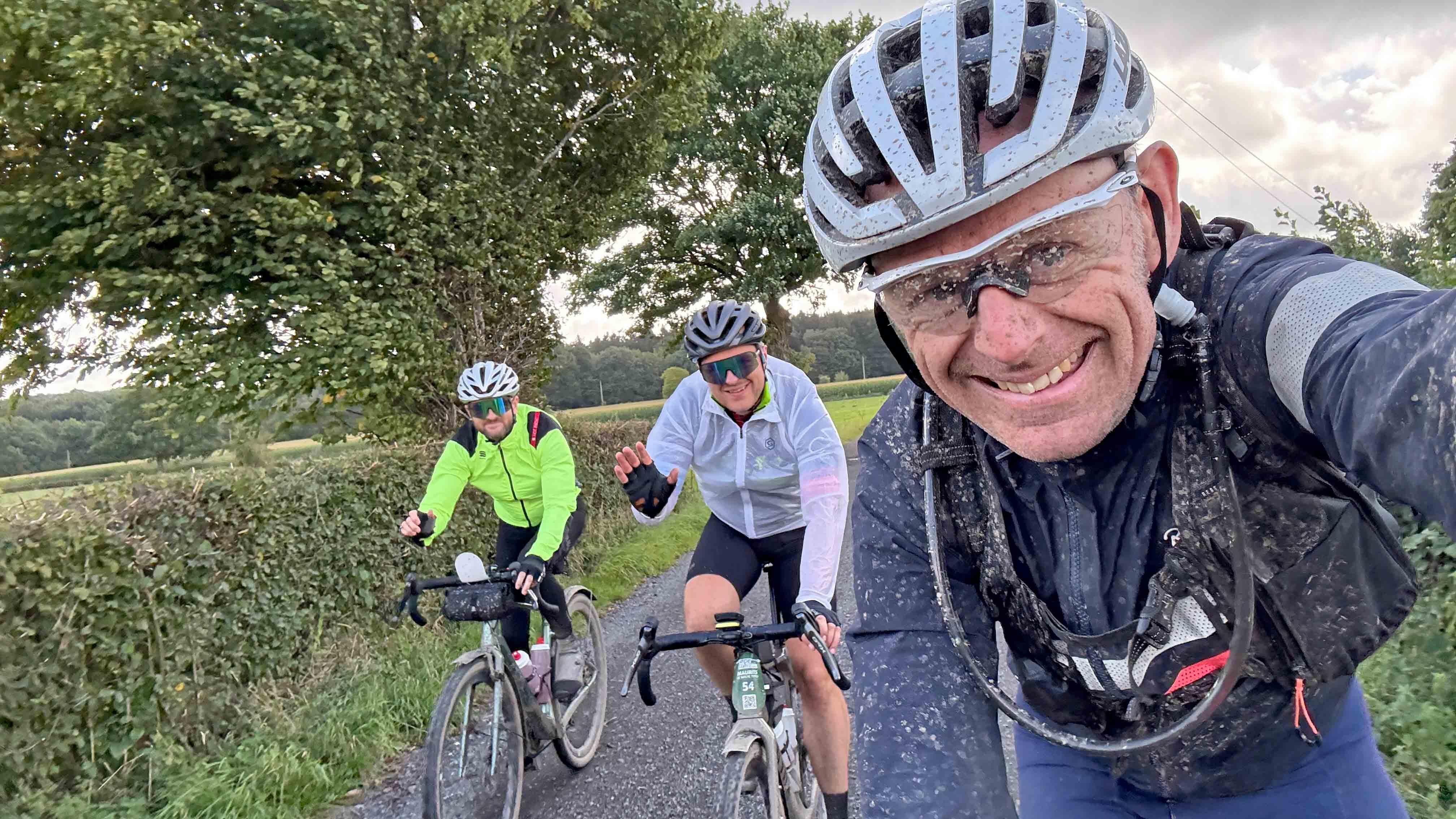
I spent the last afternoon of the final stage riding with my OG riding buddies Kenny and Maurits. We made the perfect trio for the final section, taking it in turns to push the pace, helping to steer Kenny in the right direction after his bike computer went into unintended “disco mode” and laughing at the irony of the weather gods completely soaking us with a final torrential downpour just a few kilometres before the finish line.
As we rolled over the line to a hearty welcome from Carlo and the rest of The Ride Gravel crew (who were all still "Powered by Shimano GRX"), there was a real sense of achievement, but it was tinged with sadness that the event was unlikely to run again in the future. I’d ridden a little under 500 km and climbed just over 6000m, made lots of new friends and been looked after fantastically well. I was coated from head to toe in “Belgian suntan”, my legs were cooked and my bike was making some horrible noises, but there was that deep satisfaction of having not only survived, but having had a super fun experience too. I’m keeping my fingers and toes crossed that The Ride Gravel will make an appearance again at some point in the future, but if not, I’ve got a heck of a lot of happy memories to look back on.